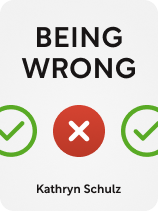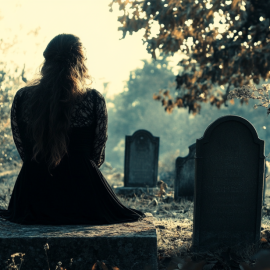

This article is an excerpt from the Shortform book guide to "Being Wrong" by Kathryn Schulz. Shortform has the world's best summaries and analyses of books you should be reading.
Like this article? Sign up for a free trial here.
Have you ever wondered why art and humor captivate us so deeply? What role does being wrong play in our creativity and individuality?
In her book Being Wrong, Kathryn Schulz explores the art of being wrong and its surprising benefits. She argues that our mistakes and misperceptions are not just inevitable—but essential—to our humanity. She shows how wrongness fuels humor, art, and personal uniqueness.
Read on to discover why embracing our errors might be the key to unlocking our full potential.
The Art of Being Wrong
In the grand scheme of things, all artistic creation exploits the same loophole of “wrongness”—the mismatch between different perceptions—that humor uses to make a joke. Schulz writes that we usually think of being wrong as a mistake. But, if we embrace the art of being wrong, we can enter into the realm of error on purpose. Art shows worlds that don’t exist, perhaps through the distortion of a painting, the soundscape of a song, or the twist of an engrossing story. Art lets us explore the unreal—the wrong—without any of the baggage we attach to misconceptions in our day-to-day lives. Beyond that, art lets us see other people’s foibles through our own eyes. When we can connect others’ wrongness with our own, we learn empathy in a way that being “right” can’t teach.
(Shortform note: When we engage with a fictional world presented through art and stories, we often say that we “suspend our disbelief,” an expression that some psychologists take literally. Because we can’t affect the story a work of art is telling, our brains don’t engage in the neural processes that would spur us to act to change the story’s outcome—the same neural connections that would normally work to fact-check whatever we’re seeing. During the time that we view a painting, watch a film, or read a book, our brains respond as if the imaginary story depicted by the art is true, even as we know—as Schulz would put it—that that belief is categorically wrong.)
Perhaps the greatest benefit to being wrong is that the unique ways in which we’re wrong are what let us stand out as individuals. Schulz suggests that our idiosyncratic worldviews, each of which is wrong in its own way, distinguish us as separate and valuable. To understand this, imagine if each of us was objectively right all the time. We’d share the same views; we’d think the same thoughts. We wouldn’t be human—instead, we’d be machines, each of us running the same operating system. Feelings like mystery, wonder, and surprise wouldn’t exist in the world of “being right.” It’s only by being wrong and envisioning a world that doesn’t exist that we open the door to such human fundamentals as imagination, aspiration, and hope.
(Shortform note: By suggesting that, if we were right all the time, we’d have the exact same beliefs and perspectives, Schulz presupposes the existence of an underlying objective reality that we would all have access to. However, even in theoretical physics there is doubt as to whether an objective reality exists. In A Brief History of Time, Stephen Hawking explains that many fundamental physical “truths”—such as where an object exists in space and time—depend entirely on the perspective of the observer. In other words, it’s possible for two people to make conflicting observations, such as how fast an object is moving or how much time it takes to travel a set distance, and both be absolutely “right” from their own point of view.)
Being Wrong Can Be Fun
The fact that our ideas about the world can be wrong is something that brings joy to all of our lives. If you find this hard to believe, consider that the disparity between how each of us views the world from each other—a multitude of opinions that cannot all be “right”—is the genesis of humor, art, and the quirks that make each of us unique.
Some people believe the whole point of humor is to point out mistakes in a way that’s pleasant and easy to digest. At its basic level, such as classic “pratfall” humor, we laugh at other people’s mistakes, and—if we’re strong enough to take a joke—we laugh at errors of our own. Schulz points out that more complicated humor also revolves around harnessing wrongness—a comedian says something that creates an expectation, then shows that expectation to be wrong in a way that briefly confuses the listener until they “get the joke.” Not all humor works this way, but enough of it does that it’s one of comedy’s defining traits, as epitomized by the medieval “court jester” who was the only one allowed to make fun of the king.
(Shortform note: Comedians can set up and subvert an expectation in a single sentence with a verbal trick called a paraprosdokian. This technique exploits the brain’s tendency to anticipate how a sentence will end based on its opening words, and then provides a different ending instead. As Schulz suggests, these verbal tricks switch the listener’s mind from “wrong” to “right” in a way that’s cognitively safe and fun, but comedians exploit other forms of “wrongness” too. One of these is breaking social taboos against addressing certain subjects, from low-brow toilet humor to politics and religion. By doing the “wrong” thing and broaching sensitive topics, comedians start dialogues on social issues that might otherwise remain bottled up.)

———End of Preview———
Like what you just read? Read the rest of the world's best book summary and analysis of Kathryn Schulz's "Being Wrong" at Shortform.
Here's what you'll find in our full Being Wrong summary:
- Why you shouldn’t try to completely avoid making mistakes
- The reasons why you get things wrong
- How to make mistakes without falling victim to shame and denial






